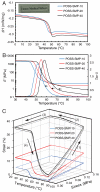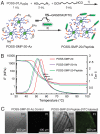High performance shape memory polymer networks based on rigid nanoparticle cores
- PMID: 20375285
- PMCID: PMC2867873
- DOI: 10.1073/pnas.0912481107
High performance shape memory polymer networks based on rigid nanoparticle cores
Abstract
Smart materials that can respond to external stimuli are of widespread interest in biomedical science. Thermal-responsive shape memory polymers, a class of intelligent materials that can be fixed at a temporary shape below their transition temperature (T(trans)) and thermally triggered to resume their original shapes on demand, hold great potential as minimally invasive self-fitting tissue scaffolds or implants. The intrinsic mechanism for shape memory behavior of polymers is the freezing and activation of the long-range motion of polymer chain segments below and above T(trans), respectively. Both T(trans) and the extent of polymer chain participation in effective elastic deformation and recovery are determined by the network composition and structure, which are also defining factors for their mechanical properties, degradability, and bioactivities. Such complexity has made it extremely challenging to achieve the ideal combination of a T(trans) slightly above physiological temperature, rapid and complete recovery, and suitable mechanical and biological properties for clinical applications. Here we report a shape memory polymer network constructed from a polyhedral oligomeric silsesquioxane nanoparticle core functionalized with eight polyester arms. The cross-linked networks comprising this macromer possessed a gigapascal-storage modulus at body temperature and a T(trans) between 42 and 48 degrees C. The materials could stably hold their temporary shapes for > 1 year at room temperature and achieve full shape recovery <or= 51 degrees C in a matter of seconds. Their versatile structures allowed for tunable biodegradability and biofunctionalizability. These materials have tremendous promise for tissue engineering applications.
Conflict of interest statement
The authors declare no conflict of interest.
Figures




Similar articles
-
In vivo tissue responses to thermal-responsive shape memory polymer nanocomposites.Biomaterials. 2011 Feb;32(4):985-91. doi: 10.1016/j.biomaterials.2010.10.012. Epub 2010 Oct 30. Biomaterials. 2011. PMID: 21040968 Free PMC article.
-
Four-Dimensional Printing Hierarchy Scaffolds with Highly Biocompatible Smart Polymers for Tissue Engineering Applications.Tissue Eng Part C Methods. 2016 Oct;22(10):952-963. doi: 10.1089/ten.tec.2015.0542. Tissue Eng Part C Methods. 2016. PMID: 28195832 Free PMC article.
-
Self-supporting polymer from a POSS derivative.Macromol Rapid Commun. 2011 Jun 16;32(12):927-32. doi: 10.1002/marc.201100167. Epub 2011 May 3. Macromol Rapid Commun. 2011. PMID: 21542047
-
Polyhedral Oligomeric Silsesquioxane Hybrid Polymers: Well-Defined Architectural Design and Potential Functional Applications.Macromol Rapid Commun. 2019 Sep;40(17):e1900101. doi: 10.1002/marc.201900101. Epub 2019 Jul 31. Macromol Rapid Commun. 2019. PMID: 31364800 Review.
-
Shape memory polymers and their composites in biomedical applications.Mater Sci Eng C Mater Biol Appl. 2019 Apr;97:864-883. doi: 10.1016/j.msec.2018.12.054. Epub 2018 Dec 19. Mater Sci Eng C Mater Biol Appl. 2019. PMID: 30678978 Review.
Cited by
-
In vivo tissue responses to thermal-responsive shape memory polymer nanocomposites.Biomaterials. 2011 Feb;32(4):985-91. doi: 10.1016/j.biomaterials.2010.10.012. Epub 2010 Oct 30. Biomaterials. 2011. PMID: 21040968 Free PMC article.
-
Copolymer Brush Particle Hybrid Materials with "Recall-and-Repair" Capability.Chem Mater. 2023 Aug 17;35(17):6990-6997. doi: 10.1021/acs.chemmater.3c01234. eCollection 2023 Sep 12. Chem Mater. 2023. PMID: 37719032 Free PMC article.
-
3D-printed NIR-responsive shape memory polyurethane/magnesium scaffolds with tight-contact for robust bone regeneration.Bioact Mater. 2021 Dec 31;16:218-231. doi: 10.1016/j.bioactmat.2021.12.032. eCollection 2022 Oct. Bioact Mater. 2021. PMID: 35415289 Free PMC article.
-
Temperature-memory polymer actuators.Proc Natl Acad Sci U S A. 2013 Jul 30;110(31):12555-9. doi: 10.1073/pnas.1301895110. Epub 2013 Jul 8. Proc Natl Acad Sci U S A. 2013. PMID: 23836673 Free PMC article.
-
Shape Memory Performance of Thermoplastic Amphiphilic Triblock Copolymer poly(D,L-lactic acid-co-ethylene glycol-co-D,L-lactic acid) (PELA)/Hydroxyapatite Composites.Macromol Chem Phys. 2014 Dec;215(24):2482-2490. doi: 10.1002/macp.201400340. Epub 2014 Sep 10. Macromol Chem Phys. 2014. PMID: 26457046 Free PMC article.
References
-
- Lendlein A, Langer R. Biodegradable, elastic shape-memory polymers for potential biomedical applications. Science. 2002;296(5573):1673–1676. - PubMed
-
- Lendlein A, Zotzmann J, Feng YK, Alteheld A, Kelch S. Controlling the switching temperature of biodegradable, amorphous, shape-memory poly(rac-lactide)urethane networks by incorporation of different comonomers. Biomacromolecules. 2009;10(4):975–982. - PubMed
-
- Knight PT, Lee KM, Qin H, Mather PT. Biodegradable thermoplastic polyurethanes incorporating polyhedral oligosilsesquioxane. Biomacromolecules. 2008;9(9):2458–2467. - PubMed
-
- Lee KM, Knight PT, Chung T, Mather PT. Polycaprolactone-POSS chemical/physical double networks. Macromolecules. 2008;41(13):4730–4738.
Publication types
MeSH terms
Substances
Grants and funding
LinkOut - more resources
Full Text Sources
Other Literature Sources
Molecular Biology Databases

